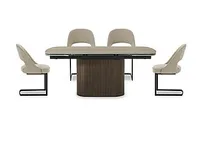From decadent decor to designs for daily life, these dining room ideas are perfect for homes of every shape, size and style
Dining room ideas are on the menu once again and we're dishing up 14 delights guaranteed to get your interior tastebuds tingling
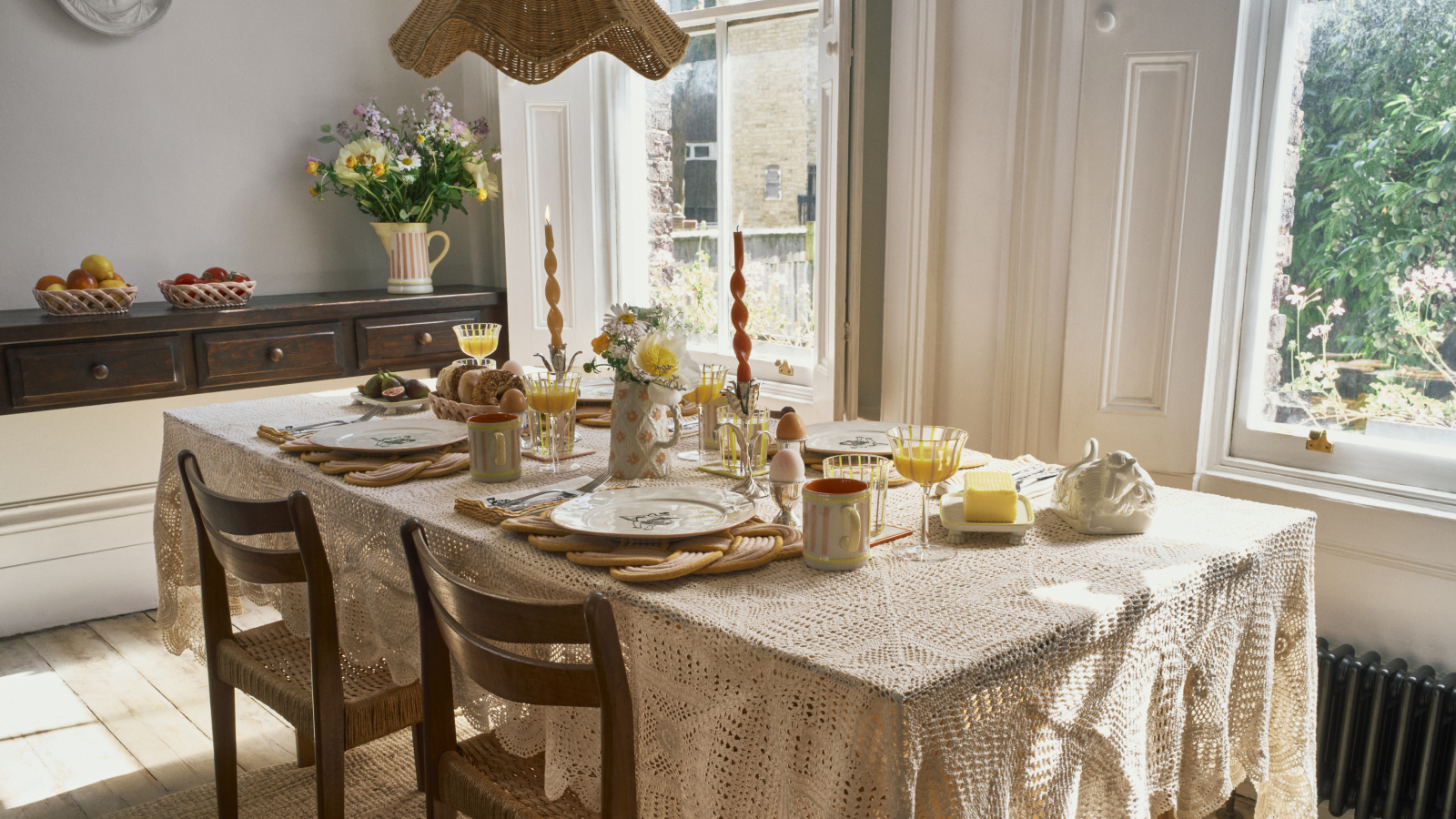
Whether your dining room ideas are for a palatial palace or a kitchen nook, creating a recognised space for mealtimes isn't just a case of finding a dining table and chairs and hoping for the best.
As with every room in your home, it's about getting the right balance between aesthetics and practicality in order that you don't just love how it looks, you love how it meets your needs.
From floor to ceiling and the space in between, we've created a menu of 14 dining room ideas to help you make sure your dining room design tastes as good as it looks.
1. Use your dining room walls as an art gallery
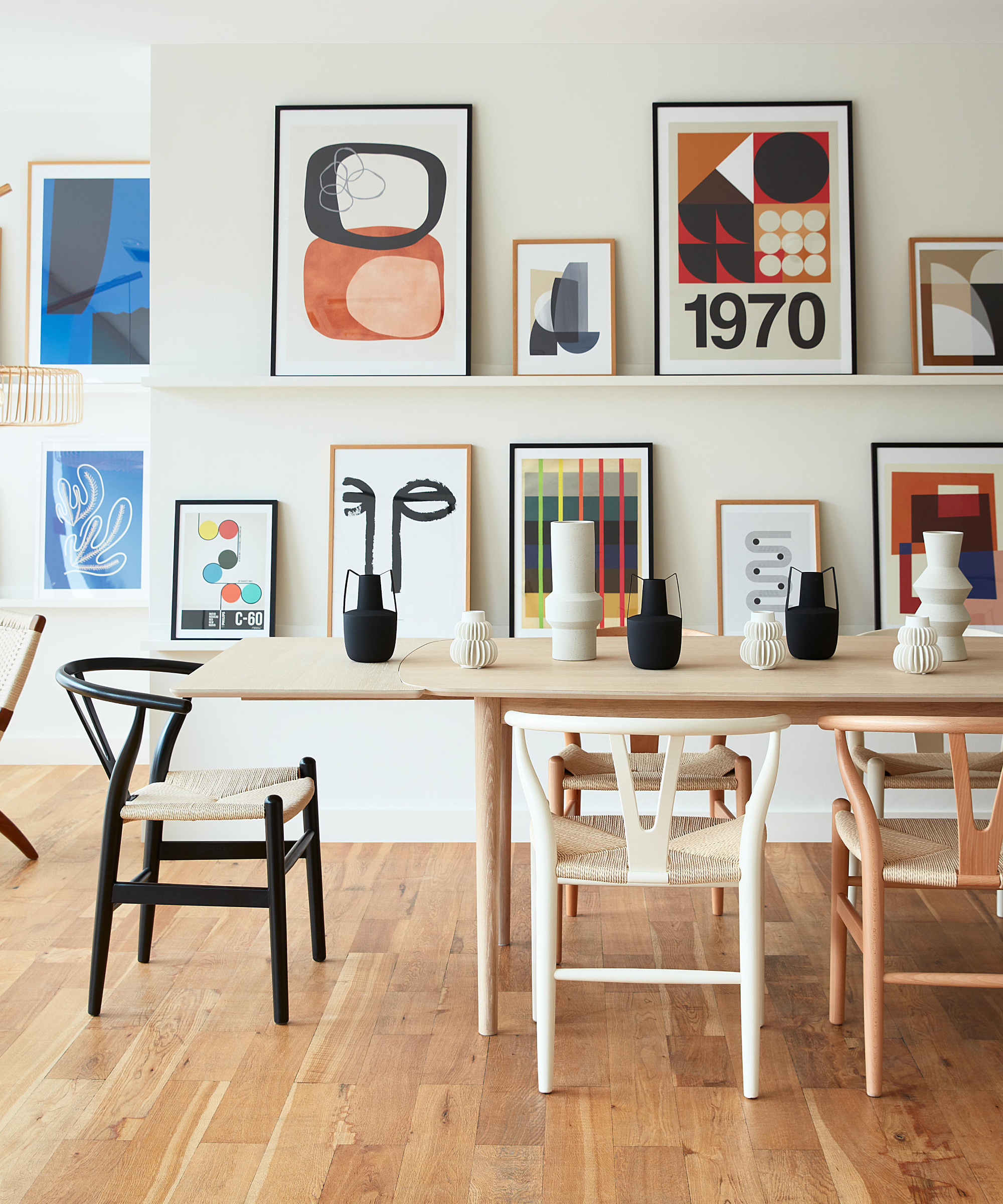
If your dining room space is purely for eating, it's possible it won't contain much more than a table, chairs and blank walls. But rather than seeing this as an issue, consider it an opportunity to create a gallery wall instead.
Stick with a neutral paint shade for your walls, such as the Natural Hessian Dulux matt emulsion paint from Wickes, and either hang pictures directly on your walls, or, use narrow picture shelves such as the Mosslanda picture ledge from Ikea.
The benefit of the latter idea is that it allows you to switch up your artwork whenever you like, turning one dining room idea into potentially different ones without too much cost or DIY.
2. Style up your ceiling with a modern chandelier
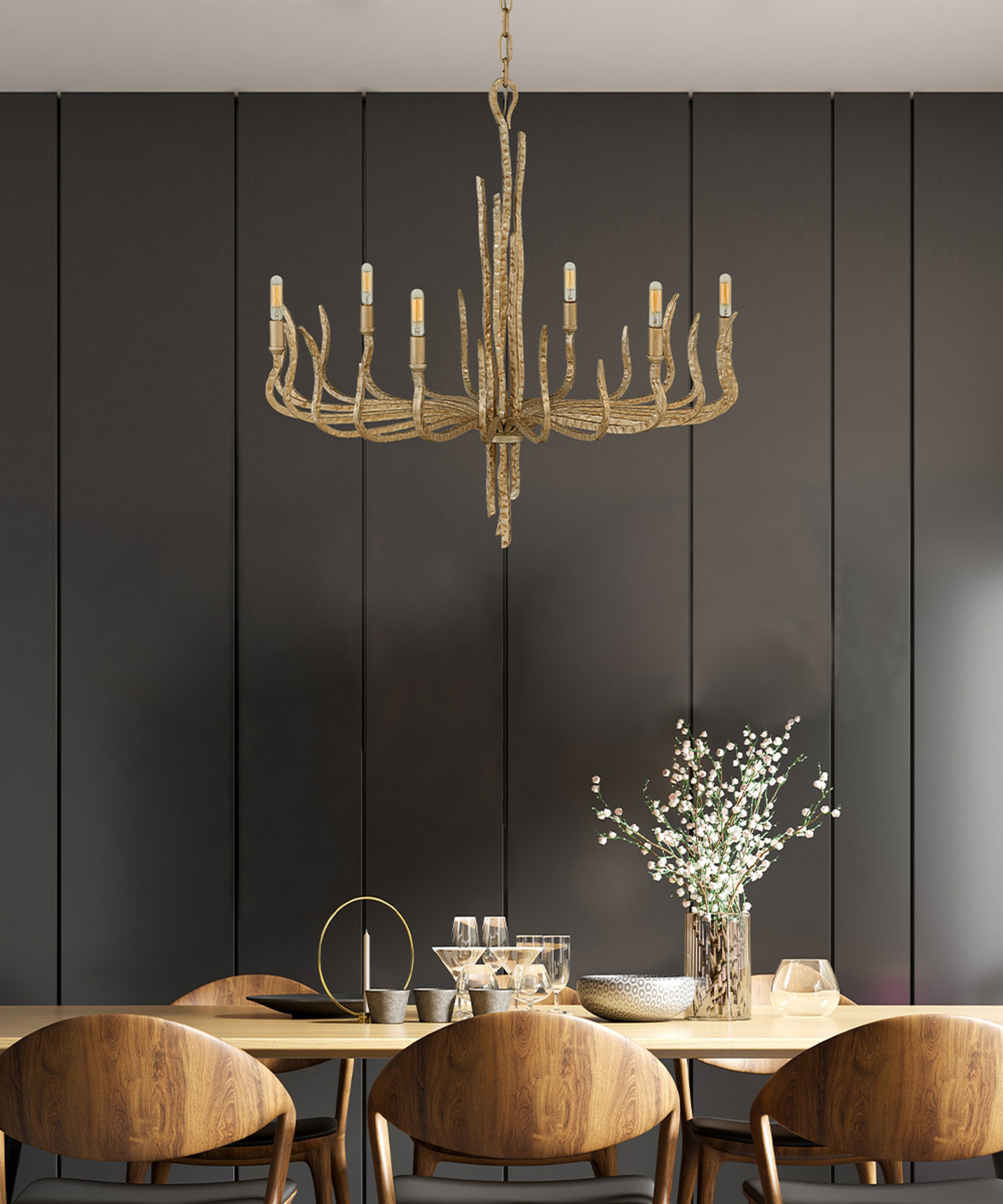
Although you may have a dining room that's used for every meal, it's not unusual to use it more in the evenings than during the day, which means your dining room lighting needs serious consideration during the design process.
Bring your dream home to life with expert advice, how to guides and design inspiration. Sign up for our newsletter and get two free tickets to a Homebuilding & Renovating Show near you.
After all, no-one wants to be blinded by overhead lights that are too bright, or find the light so dim they can't see what they're eating.
Choosing the right lighting will depend on how you use the space, and if your dining room is for entertaining, adding a show-stopping chandelier is always a good idea.
"For entertaining, statement lighting becomes your hero piece," confirms James Kendall, operations director at KES Lighting & Home. "A dramatic chandelier or sculptural pendant creates an instant focal point and sets the tone for the entire room.
"The key is ensuring it's hung at the right height, typically around 75-90cm above the table surface, so it illuminates faces without causing glare or obstructing conversation," advises James.
"Pairing your main light with dimmable wall sconces or uplighters will also help create depth and atmosphere, transforming the room from a functional eating space into somewhere guests want to linger."
Shop for dining room lights
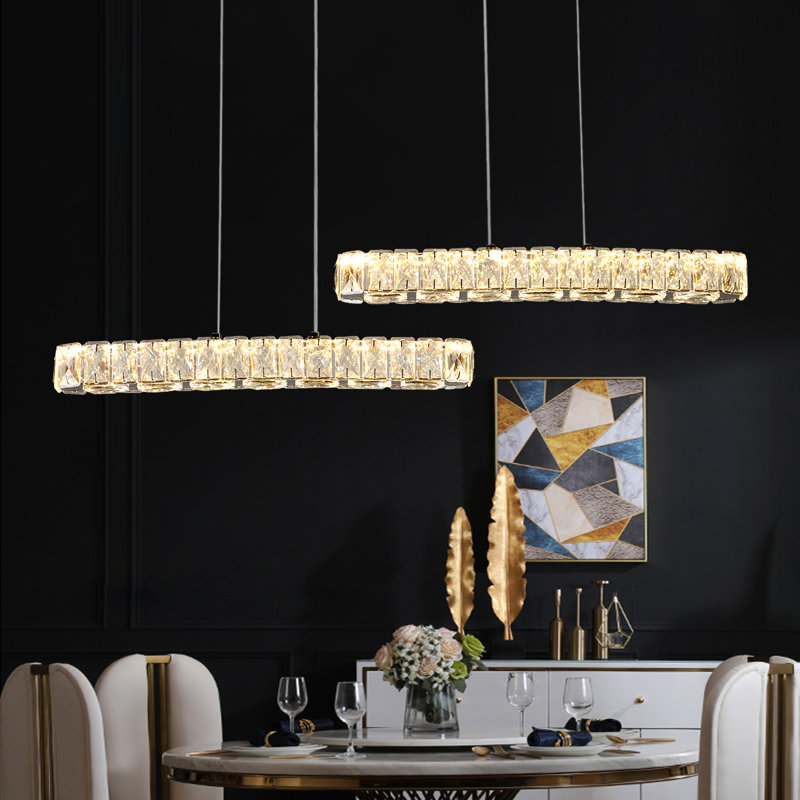
An LED chandelier made of high-quality crystal and stainless steel, casting a unique light across your dining room table
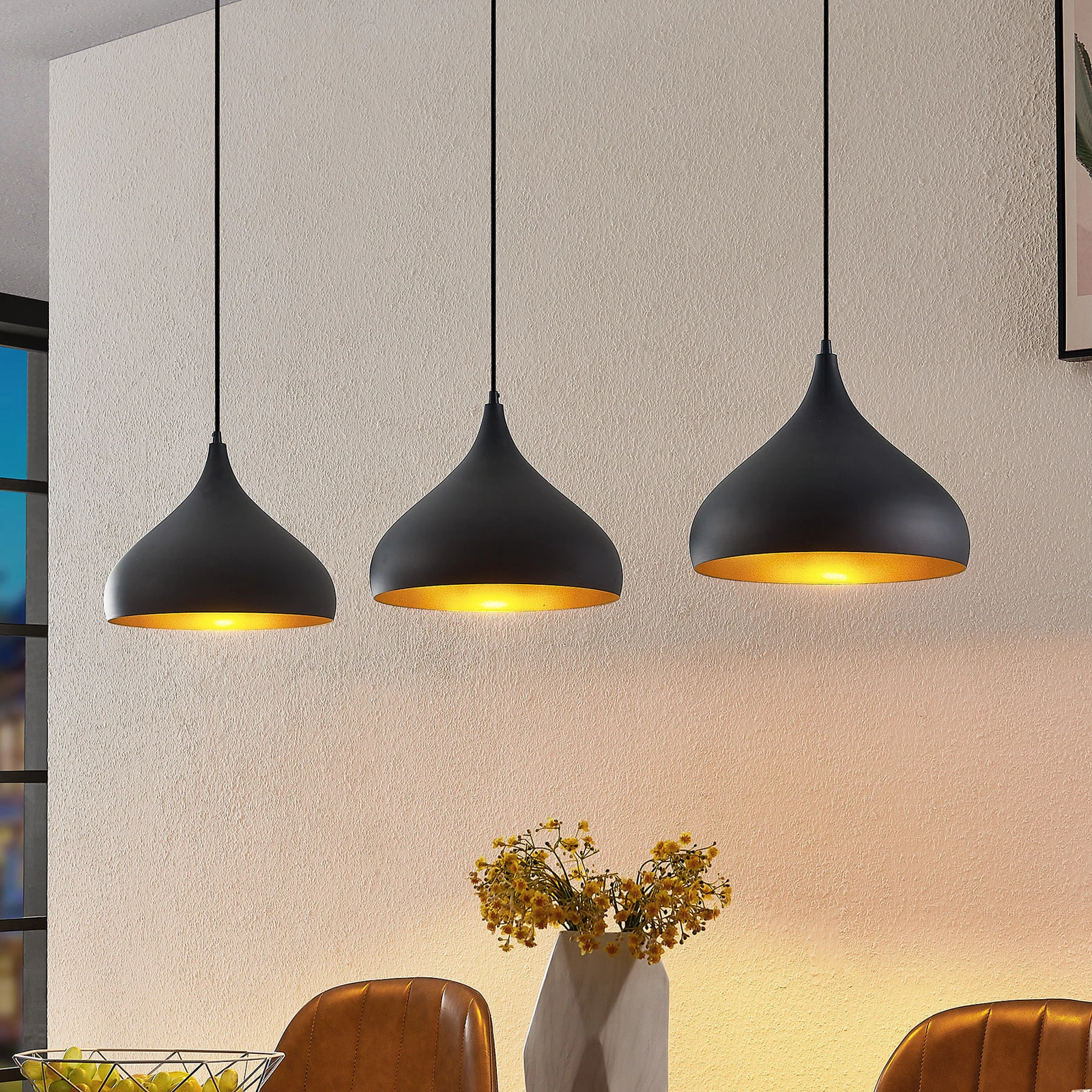
A set of three modern black shades with a gold interior to give a warm glow above your dining room table

A playful bubble inspired wall light to add interest to your dining room walls

James has a wealth of knowledge regarding how to choose best lighting for you home. From bedrooms to dining rooms, gardens to living rooms he understands just how transformative great lighting can be.
3. Maximise natural light in family orientated dining rooms

If on the other hand your dining room is more of a family focused spot, understanding the importance of daylighting will be imprortant when finalising your dining room ideas.
Here, a simple lean to extension has created the perfect dining room space, flooded with natural light thanks to the large window and pair of rooflights positioned above the dining room table.
The key to a relaxed comfortable setting? "Soft furnishings are key here," says Debbie Leigh, design manager at ILIV. "Luxurious floor-length curtains can instantly elevate the atmosphere, adding softness and a sense of occasion. Upholstered dining chairs or benches with bold fabrics or textures are a great way to add comfort and style, and you can have fun mixing colours or patterns to really make a unique statement.
"A well-dressed table is also central to the dining experience," she adds. "Consider layering a beautiful tablecloth with coordinating napkins, runners, or placemats to reflect the seasons or the tone of your gathering. Soft furnishings will also help with acoustics, making conversations feel more intimate."

Debbie is an expert in creating beautifully coordinated fabric collections that can be easily combined to create harmonious interior schemes. With more than 30 years of experience, she takes every design from conception right through to the finished textile - inspired by the latest trends and techniques from every continent.
4. Wall panelling works well in dining room ideas
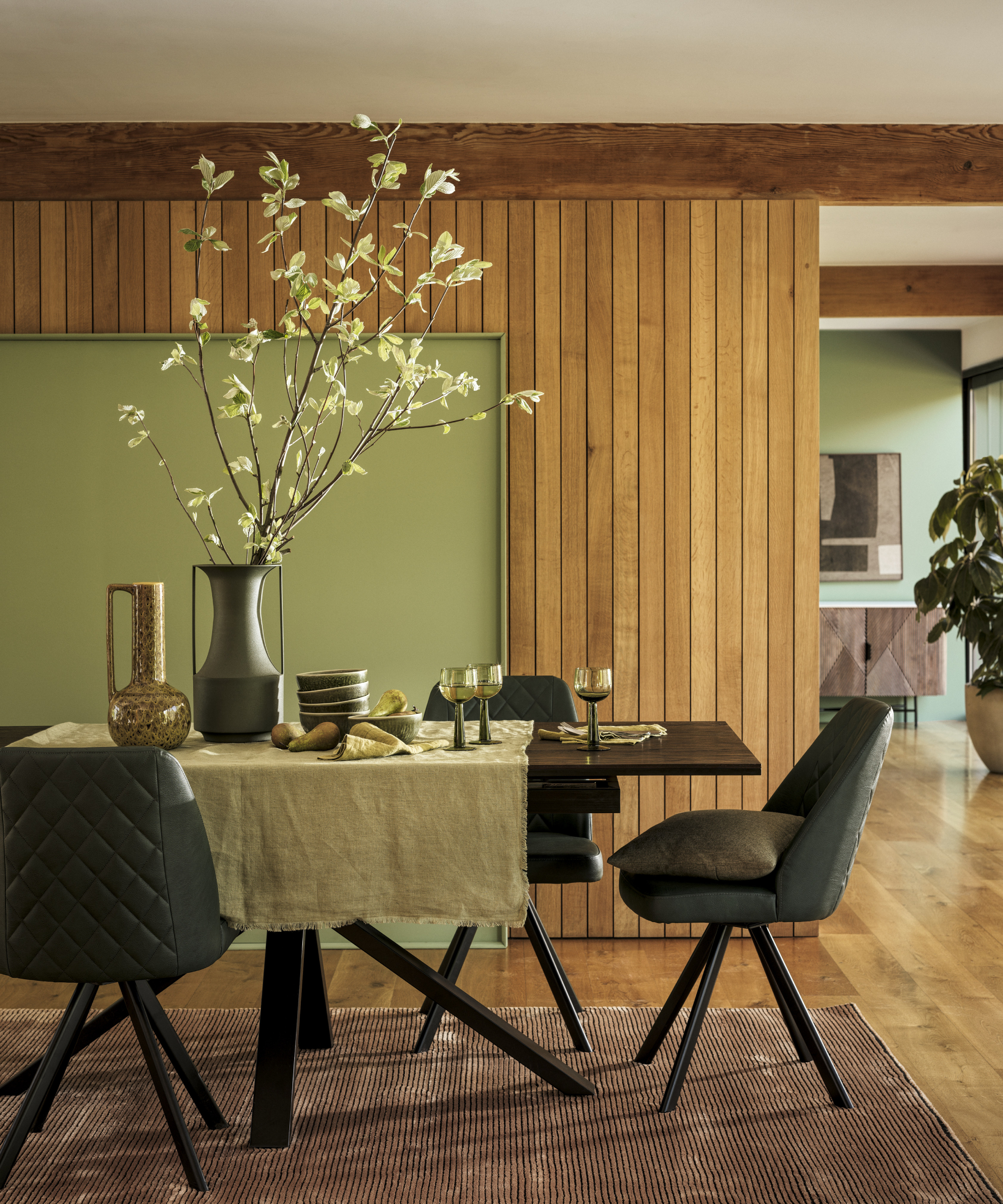
The appealing of wall panelling continues to grow in interiors, with a vast array of styles and designs suitable for using across the entire home.
From waterproof wall panelling in bathrooms, to acoustic contemporary slats that are practical in your home office ideas, dining rooms are also a great spot in which to try out this popular wall feature.
Here, vertical timber slats add a modern touch to this timber beamed dining room with wooden flooring. Helping not just to zone the space, but also to create the sense of a fully enclosed room – perfect for when your open plan living room needs some broken plan touches.
Try these Wickes V-jointed Traditional Softwood Cladding panels and stain them yourself, to create your own version of this dining room idea.
5. Think carefully about your dining room colour choices
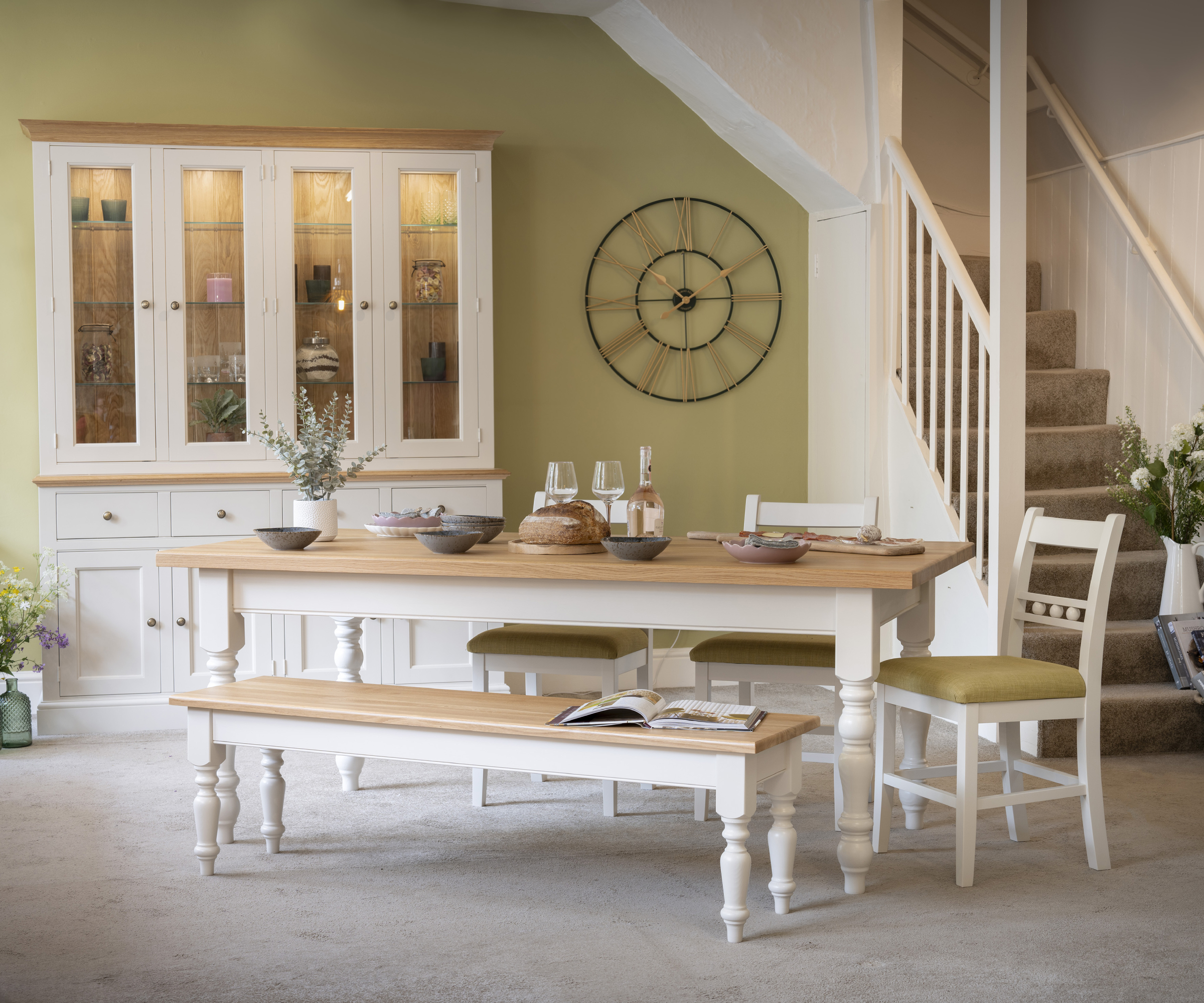
When choosing paint colours for your dining room, take care to consider the orientation of the room to get the most out of your selected shade.
North-facing dining rooms can bring out cooler tones in shades such as grey for example, while south facing spaces will bring out the best of subtle, more neutral hues.
Using size to guide you towards the best colours is often a good starting point, says Kate Palmer, creative director of The Painted Furniture Company, along with some other techniques that help a small space look bigger.
"A dining room doesn’t have to be a large room and if yours is on the smaller side, there are several things you can do to make it work well. You might consider using a light colour palette and narrow or compact furniture to make the most of the space," she suggests.
"An extendable table is a good flexible choice too, so that you can keep it small for everyday use, ensuring the room has a good flow and is usable on a day-to-day basis. Bench seating is also good for making the most of unused corners," she adds.

Kate Palmer is the creative director at The Painted Furniture Company. With a background in fashion design and passion for colour and interiors, Kate has helped many customers to achieve the exact look they desired for their home.
6. Pick practical flooring when there's a connection to the outdoors

If your kitchen extension includes space for a dining table and chairs, plus bifold or patio doors leading outside, you'll want to make sure that your dining room flooring is up to the job of dealing with the dirt.
It's not uncommon to choose a harder surface for your dining room floor as mealtimes can often be messy, making carpet less of a popular floor finish. Both wood and tiles are good options, particularly when during the summer months foot traffic may flow in and out of the space.
These large flagstone style floor tiles are perfect in a cottage kitchen idea, providing an easy to keep clean solution in a busy family environment.
7. Go large on pendant lighting if you're blessed with high ceilings
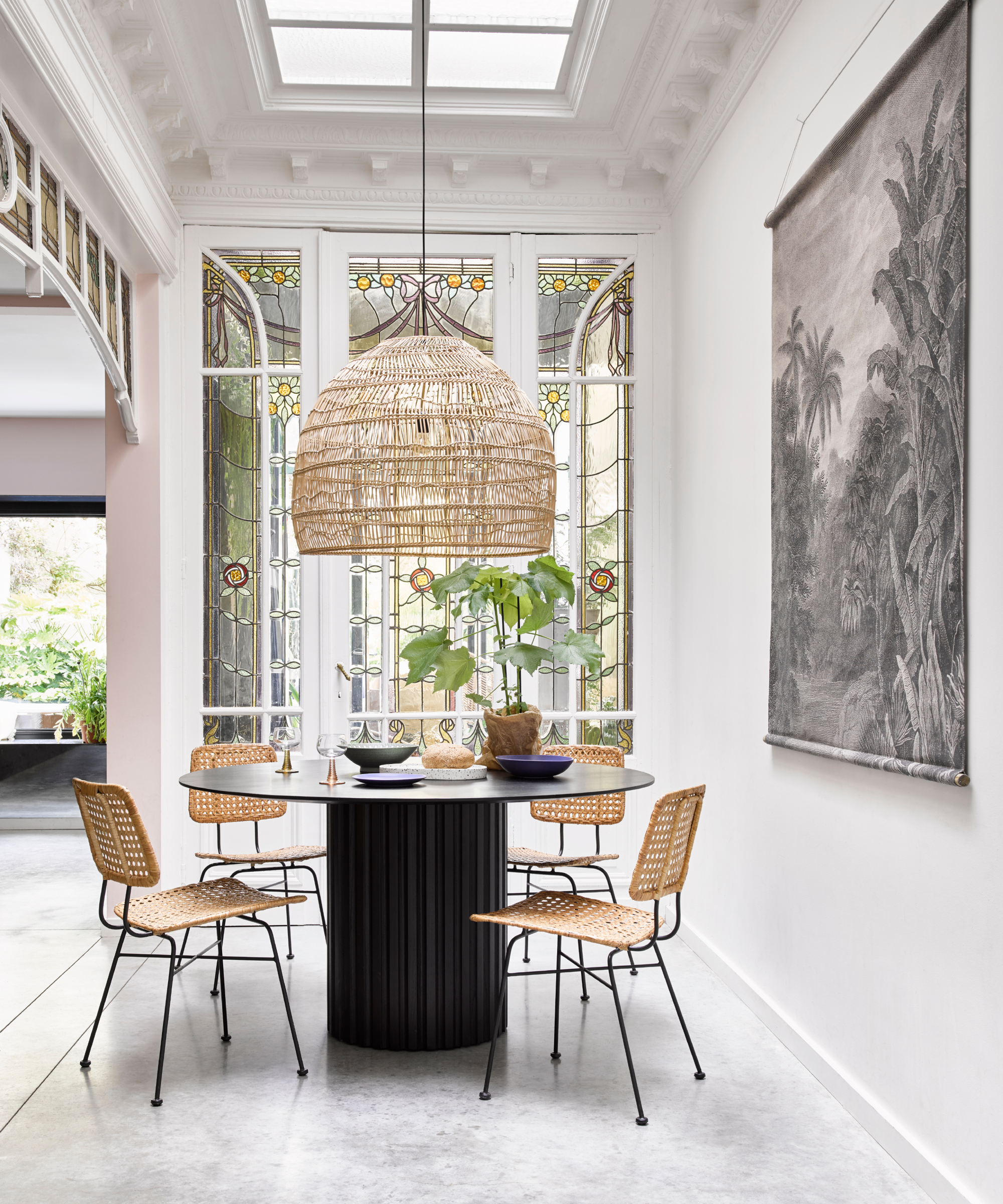
if you're renovating a house where the original features mean you're blessed with high ceilings, ornate plasterwork and stained glass features, don't feel like this means you need to dim the light on your dining room decor.
In fact, it's the opposite. Every item in your dining room space needs to stand up and be counted, particularly when choosing your lighting and furniture. In a narrow dining space such as this, a round table and chairs is the perfect choice as it not only fits, but helps break up the otherwise angular room shape.
A larger than life pendant light hangs proudly above the table, while a black and white wall hanging turns a blank wall into a feature wall with ease. And even though you could assume you don't need a pendant light in a naturally airy room, it's still worth having one, says Ally Dowsing-Reynolds, lighting expert and co-founder of Dowsing & Reynolds.
“It is always best to have some form of light over your dining room table as it will help everyone sitting around the table be able to see their food and drink and also illuminate tablescaping displays.
"People also naturally gravitate towards pools of light so an over table light helps to create an intimate ambience that encourages conversation too," she adds. “I always recommend customers opt for a chandelier, singular statement pendant or even a cluster of pendant lights to create a striking design feature."

Ally Dowsing-Reynolds is co-founder of interiors brand Dowsing & Reynolds. With over 20 years’ experience, she specialises in creating lighting schemes that bring warmth, atmosphere and character to everyday spaces.
8. Pair banquette seating with wood flooring
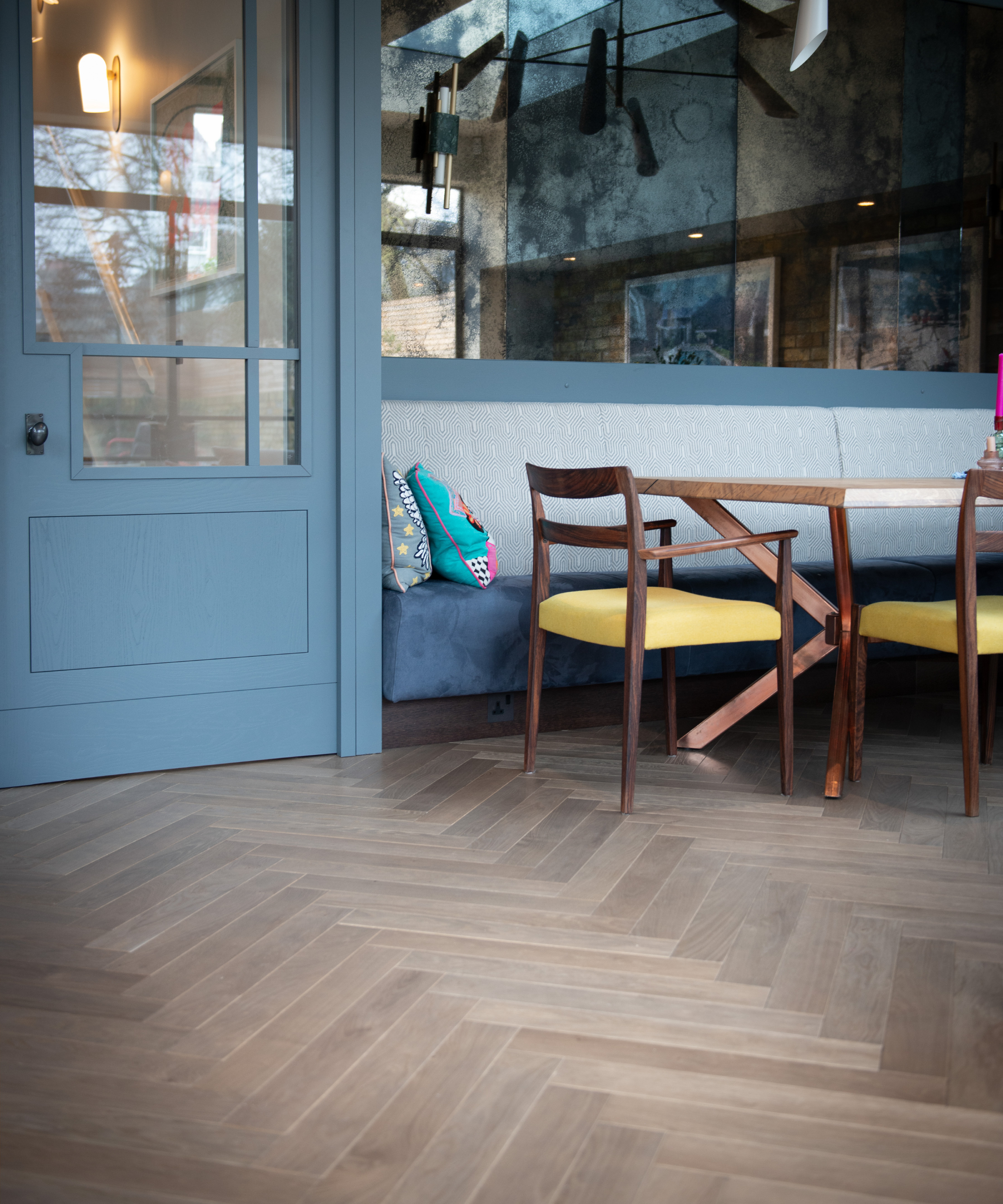
Dining rooms traditionally were the place to entertain away from the noise of the rest of the house but as our lives change, so do our homes. Modern casual dining with the family at the end of the day takes just as much precedent as impressing guests.
Relaxed furniture – like banquette seating is a great way of creating a comfy spot to catch up on the events of the day. And, to add warmth and practicality to your dining room flooring, pair with herringbone laid planks say industry experts – but make sure you choose the right product and finish.
"Engineered wood flooring is the best choice for dining rooms due to its structural stability," says Ian Tomlinson, managing director at Chaunceys Timber Flooring. "Unlike solid wood, engineered wood is designed to handle fluctuations in humidity and temperature, making it more suitable for moisture-prone areas. Its multi-layer construction offers enhanced stability and resistance to warping, even in high-traffic areas and it’s also suitable for installation over underfloor heating systems."
"For kitchens and dinging rooms, consider opting for a lacquer finish," adds Adam Robertson, managing director at Urbane Living. "It offers easier maintenance and added resistance to spills and stains, making it a practical choice for busy cooking spaces without compromising on style."
But, regardless of the finish, make sure you clear up spills promptly to prevent moisture-related issues such as staining.
9. Mix and match for an eclectic dining room idea
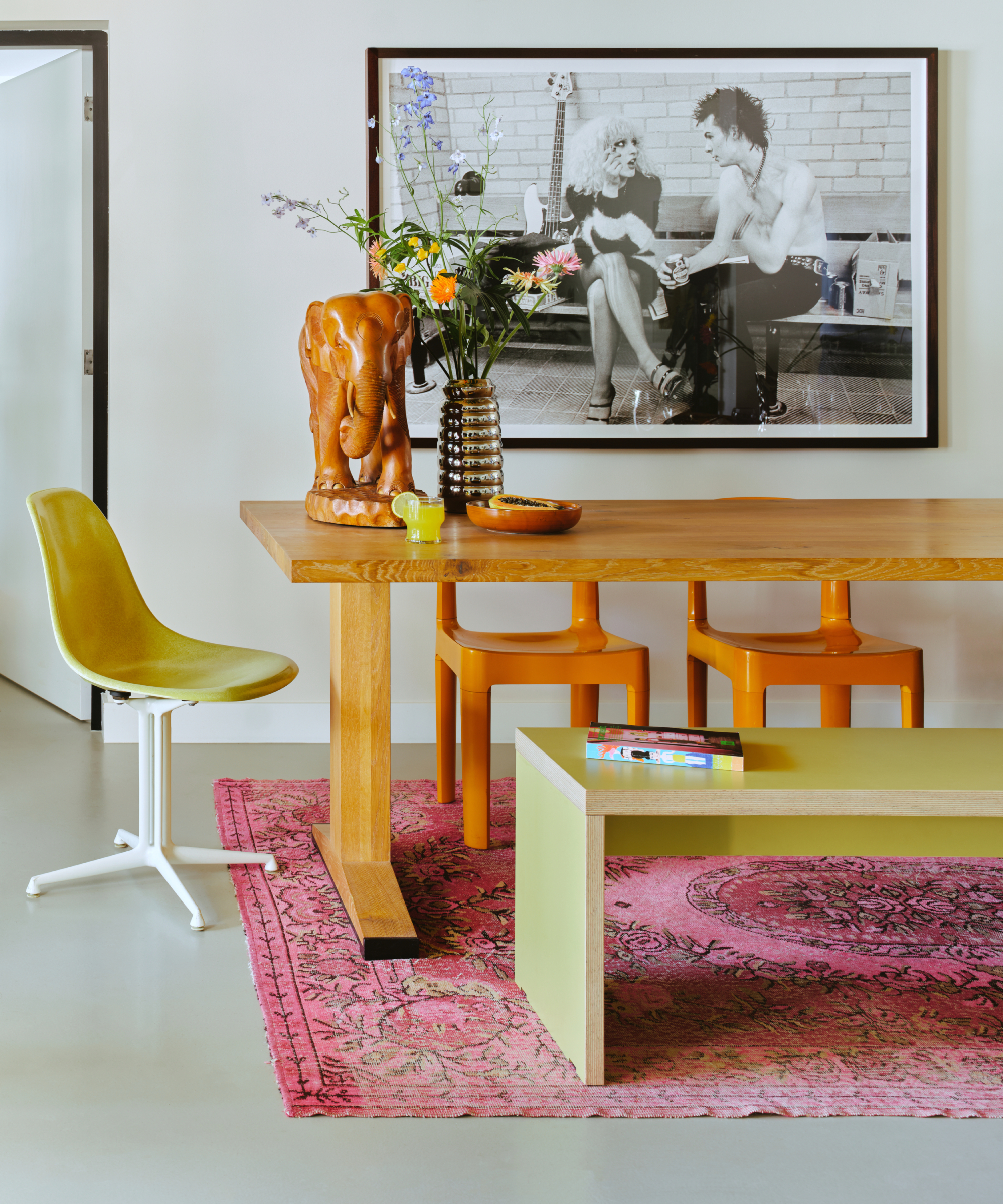
If the fact dining rooms are back in fashion isn't sounding overly appealing to your eclectic sense of interior design, it doesn't mean you have to create a formal dining space that's bound by rules and regulations.
Instead, embrace your preferred aesthetic and opt for a mix and match approach to add character to your dining room ideas.
"A dining room doesn’t have to be formal or reserved only for special occasions," agrees Kate Palmer. "With the right design and furniture, it can be a welcoming, everyday space that encourages conversation, making it easy to check in with each other, share stories and reflect on the day."
"Remember, a well designed dining room should be a true reflection of your own personal style and how you live - warm, welcoming and undeniably personal,” adds Amanda Huber, creative director at The Dining Chair Company.
Check out this dining room table and chairs on offer
This wooden extendable table and four boucle dining chairs is currently on sale at Furniture Village and can seat up to 8 guests when extended

At the heart of Amanda’s work is a passion for the synthesis between classical and contemporary design. This, combined with an instinctive feel for each client’s very individual needs is what makes her approach so special. She studied Architectural history at Cambridge, and after a career in advertising, Amanda set up her Interior Design practice WH Designs, and now brings her experience to The Dining Chair Company.
10. Are you seating comfortably? In dining room ideas chairs are extra important
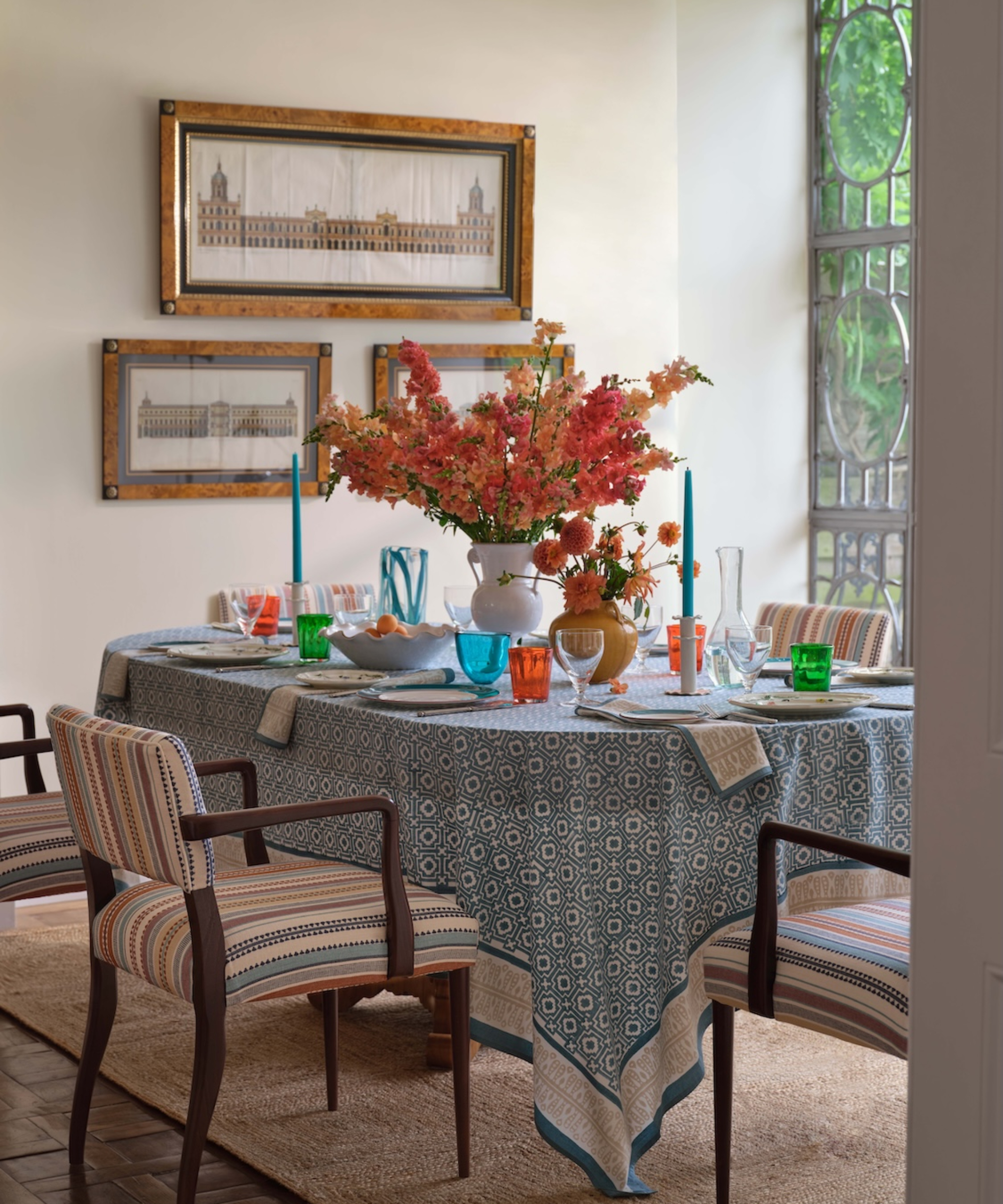
One of the main items on the menu for your dining room ideas is your dining room chairs. Seating yourself and your family or guests comfortably is essential for an enjoyable mealtime. But how do you know which chairs to choose when there's so many different styles, shapes and sizes on offer?
"For your seating, you want to strike the balance between comfort and design," says Amanda Huber. "Upholstered dining chairs remain a timeless choice, allowing you to add all of the comfort with unexpected design details depending on the fabric you go for.
"Dining benches will bring a more relaxed and casual feel, and often prove popular for those with young families," she adds. "Upholstered designs in these also continue to lead the way forward, especially with the amount of performance fabrics on the market these days, with stain-resistant velvets and easy-clean linens making it easier to combine luxury with longevity, even in the busiest of households."
11. Don't be afraid to bring bold colours into your dining room ideas
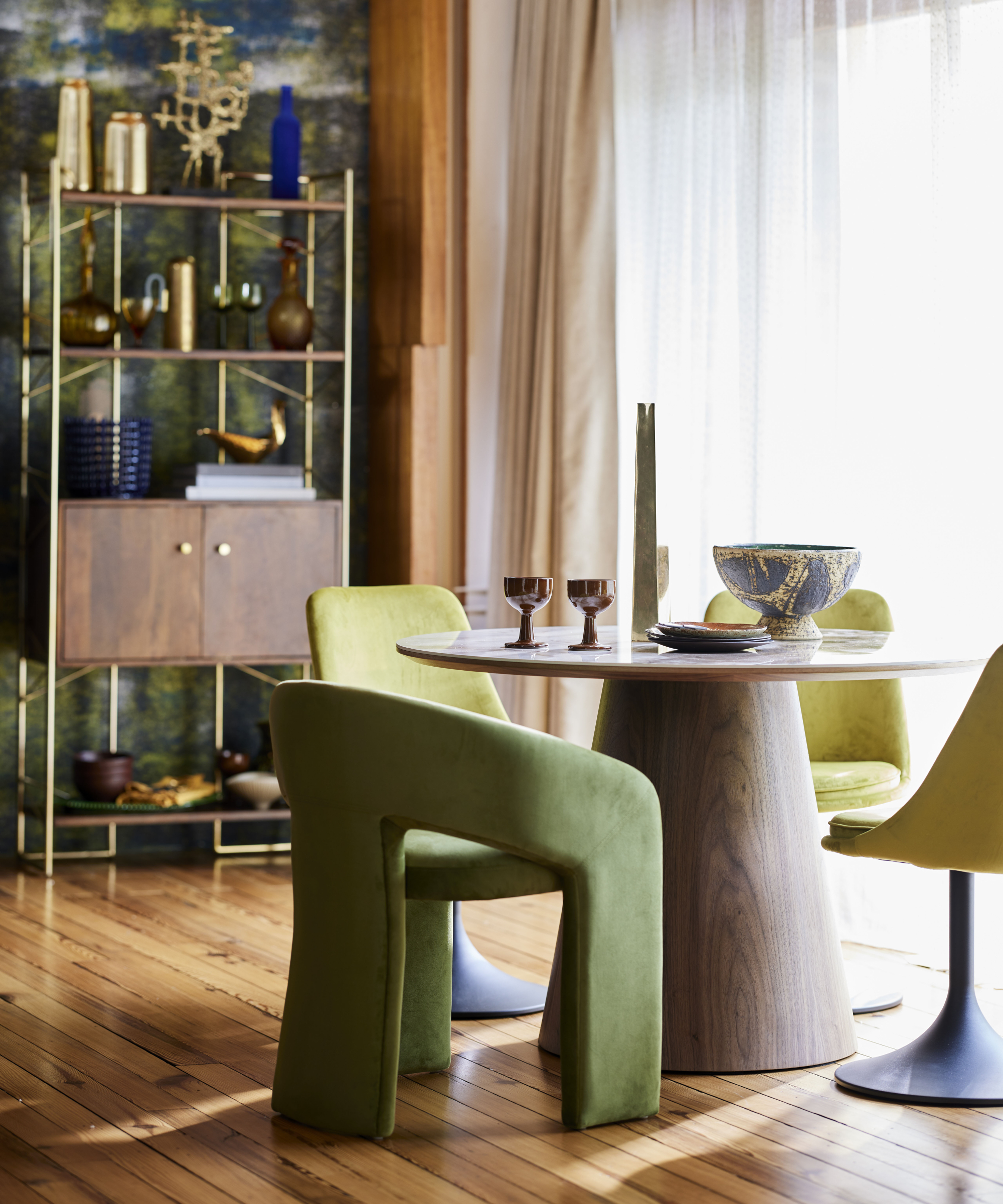
In much the same way as we're seeing timber and warm earthy tones feature in kitchen trends in 2026, they're also making their way into dining rooms too, says Amanda Huber.
"The fact the dining room is separate from the main living areas, means it presents a wonderful opportunity to experiment with design and embrace a touch of drama or elegance," confirms Debbie Leigh.
"From a design perspective, we’re definitely seeing homeowners be braver with their design choices," agrees Amanda Huber. "They are moving away from the modern minimalist greys and monochrome schemes, and instead choosing earthier, richer colours such as greens, reds, browns and warm neutrals.
"These spaces can then be brought to life with statement lighting, sculptural tableware or bold textiles for a touch of personality," she adds. "For those who are braver with their design choices, bold patterned fabrics and vibrant colour accents can really allow your personality to shine through, while creating a memorable setting for every meal."
12. Add a bar for a decadent touch

If you love to entertain, there's a chance you've often considered ways of incorporating a home bar into one of the rooms in your home. A dining room is a great spot to install one, and having a bespoke home bar built into the wall alcoves either side of a fireplace can be perfect for Victorian home renovations.
Our expert's top tip for styling your home bar? Don't forget to include it in your lighting design.
"Accent lighting, such as picture lights or spotlights highlighting artwork or architectural features, adds interest and draws the eye around the room," explains James Kendall. "Decorative elements like candles or LED strips in display cabinets contribute to the overall ambience. This layered approach ensures your dining room feels considered and complete, not just a table with a light above it.
But how many layers do you need?
“I always suggest layering your lighting with up to eight light sources in one room," says Ally Dowsing-Reynolds. "Add table lamps and more ambient light sources, to create an inviting atmosphere, and if you have other pieces of furniture in your dining room, such as a bar cart or cabinet, adding a lamp or an illuminated decoration here will help to add further interest to the room."
13. Consider your heating for comfort and best use of space
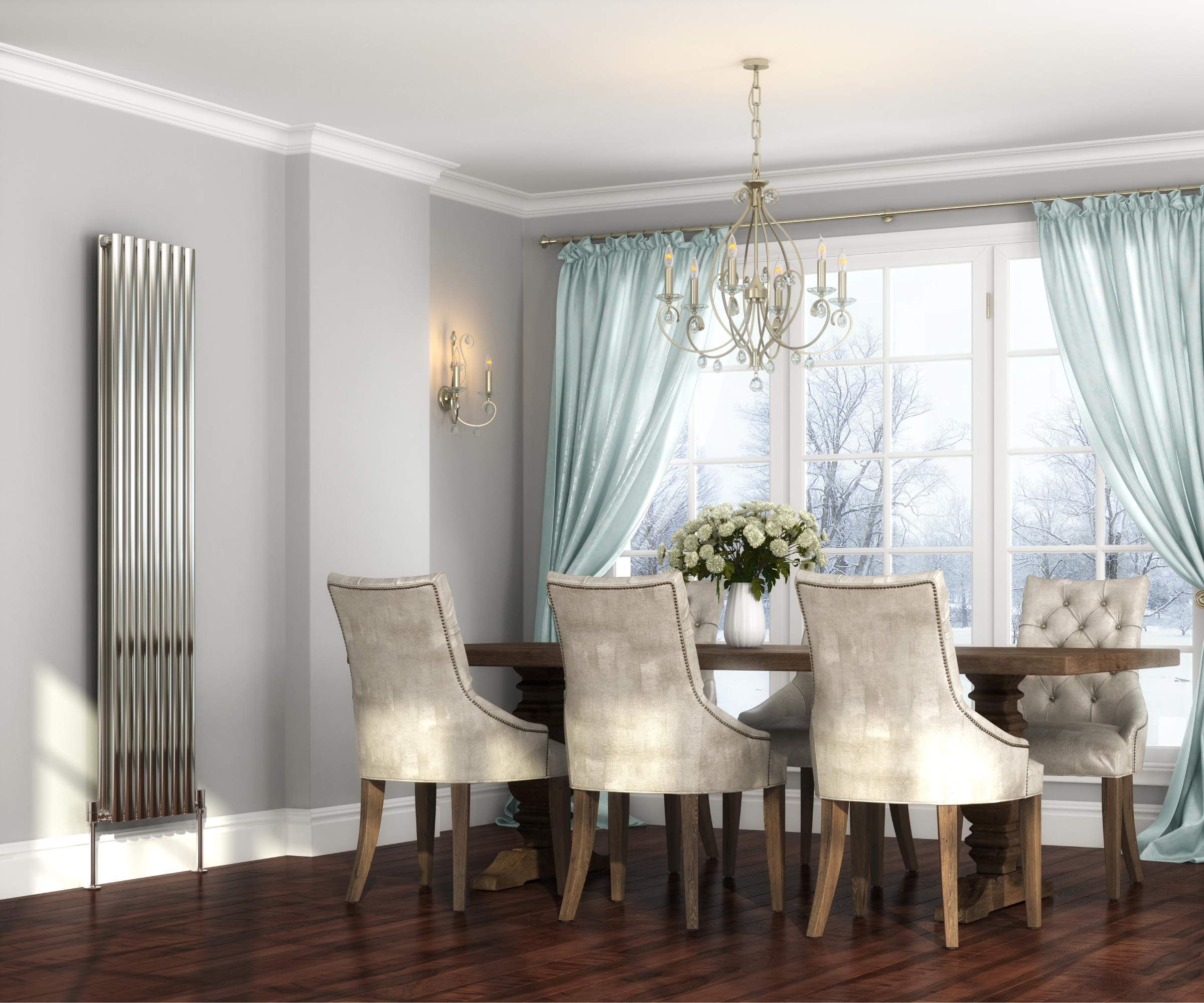
While underfloor heating remains a popular choice in dining rooms, if your home is heating with radiators, think carefully about where you will position them in a dining room, and how they look.
Chrome is in fashion, so a mirrored chrome surface finish is one option for adding an up to date trend into the room, and a way of making the space feel bigger. A wall mounted radiator is also perfect if you're tight on space and don't have space for a more traditional cast iron style emitter.
In terms of positioning, you'll also want to ensure your radiator isn't directly behind one of your dining room chairs, not only to to avoid placing an uncomfortable direct heat source on the chair's inhabitant, but also to ensure there's enough room behind to move in and out comfortably.
As a guide, working from the dining table dimensions, create a minimum of one metre circulation space and ensure spacing between chairs is around 45-60 cm.
14. Use an archway to define your dining room

If you're considering a single storey home extension, it can be tempting to try to cram everything you need into one open plan layout so that you don't end up with smaller spaces that feel cramped or compact.
However, unless you have a back kitchen to hide away cooking clutter, keeping your dining room separate has many benefits, especially when entertaining. If adding a stud wall with a door feels too enclosed, why not opt for an arched entrance instead?
Leaving the entrance open, but partially contained gives this dining nook a warm and cosy feel come evening fall, while the large picture windows ensure there's still plenty of light during the day.
For a final touch of cohesion, as well as running a similar colour scheme throughout, "if the dining room forms part of an extension, it’s best to choose a continuous floor finish that runs seamlessly from the existing space into the new area, avoiding visual breaks that can make the room feel smaller," advises Adam Robertson.
With lighting such an integral part of your dining room ideas, make sure you're aware of the main lighting design mistakes before you start purchasing your fixtures and fittings.
And, if you need to incorporate your dining space in your kitchen, take a look at these kitchen diner ideas for more inspiration.

Sarah is Homebuilding & Renovating’s Assistant Editor and joined the team in 2024. An established homes and interiors writer, Sarah has renovated and extended a number of properties, including a listing building and renovation project that featured on Grand Designs. Although she said she would never buy a listed property again, she has recently purchased a Grade II listed apartment. As it had already been professionally renovated, she has instead set her sights on tackling some changes to improve the building’s energy efficiency, as well as adding some personal touches to the interior.
